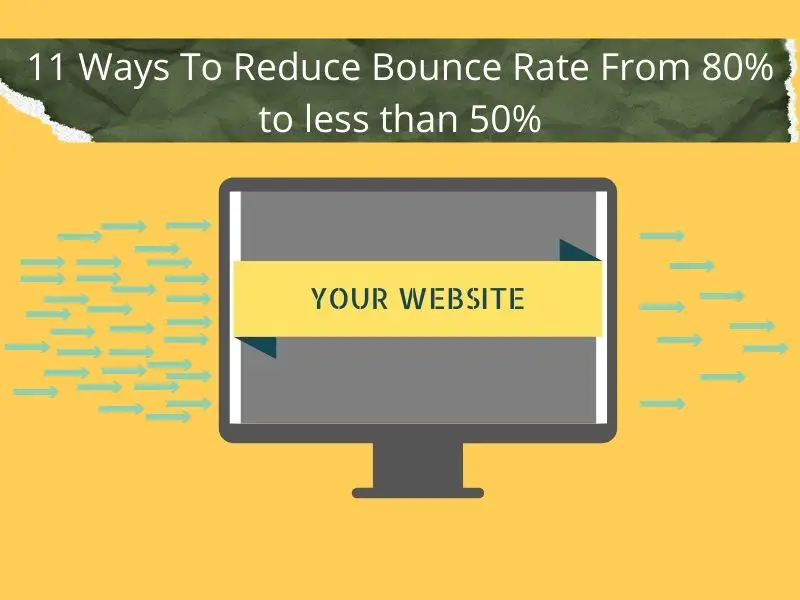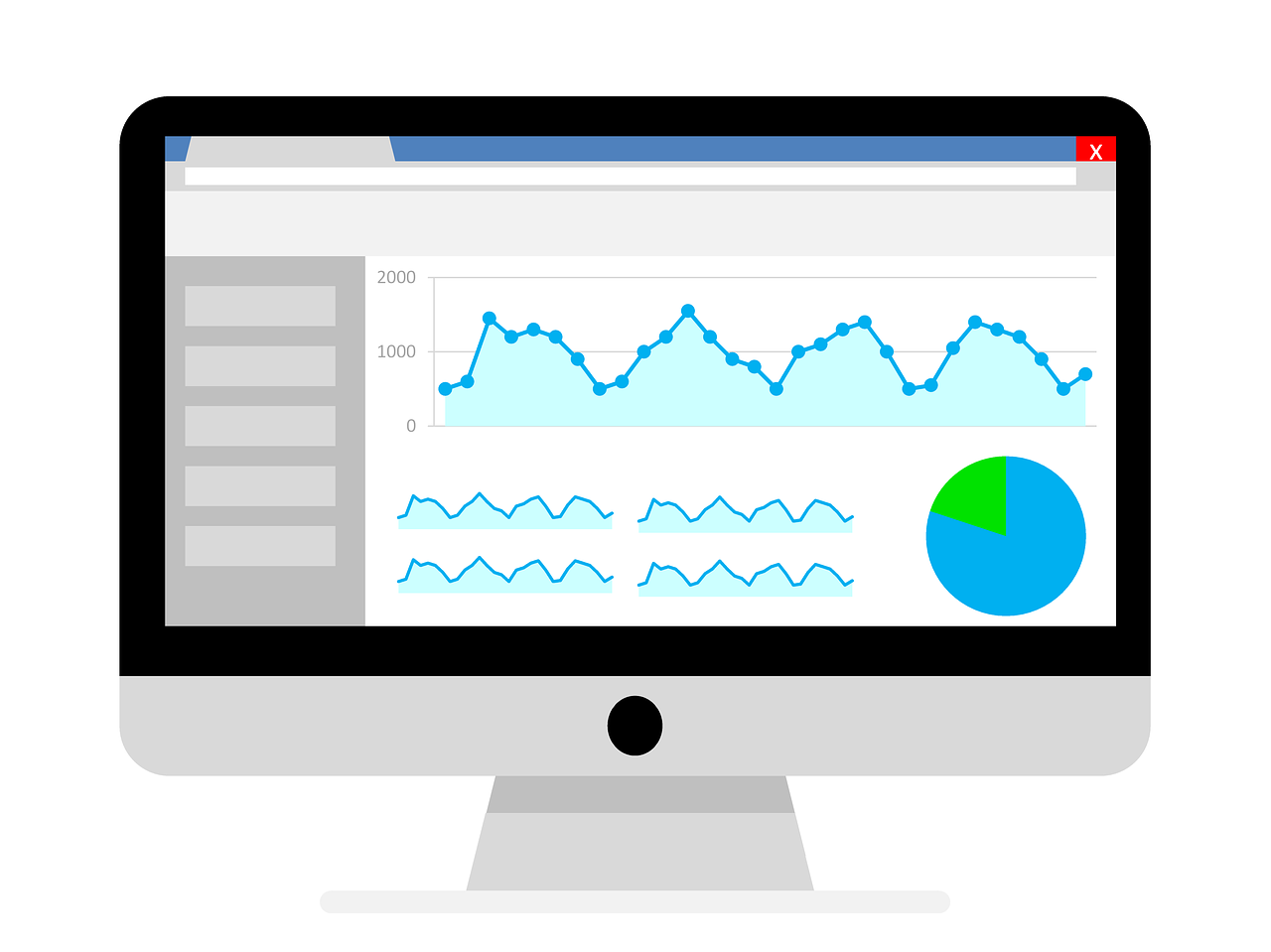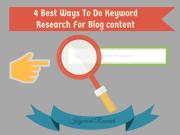Best 11 Ways To Reduce Bounce Rate From 80% to less than 50%

While most businesses today focus on increasing their website traffic but forget to consider the most important factor, i.e., bounce rate. If you are struggling to drive traffic to your website, build an email list, get more leads and acquire more customers, it's due to your bounce rate being too high.
There are many ways to increase traffic to your sites like Social engagement, paid media, and content distribution but understanding the power of a bounce rate is also vital to measure your success.
What is Bounce Rate?
Bounce rate is the percentage of site visitors who land on your website and leave after viewing a page without taking any action. The Bounce Rate according to Google Analytics, is the number of visitors viewing a page and exiting from that same page.
It also the percentage of single-page sessions on your website. A bounce happens when a user visits your site on any page and leaves without visiting other pages or taking any action that you offer based on your products or services. There are a lot of ways that constitute a bounce rate like -
- Quickly quitting the page
- Type another URL
- Close the window or tab
- Click on external links
- Timeout
Bounce rate is calculated as the single page session which is the number of visits as a proportion of total visits, where the visitor leaves your site without going to other pages. The bounce rate can be high, average, or bad, and it differs a lot from industry to industry,
website design, landing pages, design, etc.
1) Low or good bounce rate indicates that customer engagement is good on your site and it's between 20% to 35%.
2) Average bounce rate is between 56% to 70% depending on your website
3) Bad bounce rate is anything over 70%
There are many ways to reduce the bounce rate for your website ranking but here are the
Top 11 Ways to Reduce Bounce Rate and Improve Engagement.
1) Optimize your website content
Optimizing the content is the biggest factor that increases the user's readability on your website. It is one of the best approaches to grow a site, so keep posting regular content that will help you rank higher on search results. This will make users stay on the page, increase dwell time and reduce bounce rate. It is important to optimize keyword density, meta tags, header tags, and other on-page SEO techniques along with it.
The entire goal is to use the right keywords in the content, optimize the content on what people are looking for and bring traffic to the site consistently in the long run.
- Create headings and sub-headings for your content
- Use keywords and make it bold
- Images should be relevant to your content
- Use bulleted points to show any benefits
- Engage your audience by asking questions, giving offers, etc.
- End with an actionable conclusion
- Use only 3 lines for every paragraph to make content more interesting and stay users for more time on the site. This will have a huge positive effect on the site bounce rate.
2) Stop using Ads and Pop-ups
Using more ads and pop-ups is the main cause of visitor frustration, and hence increases bounce rates. While several marketers use these options to drive customer's attention to their products or services.
We are not against ads or pop-up notifications, the main focus is not to frustrate the users but to stay on your page for more time by building quality information. If you are using then remember:
- Know your audience interests and behavior
- Don't use abusive language
- Use real facts and figures in your content
- Customize your pop-ups based on users purchased or browsing history
- Select a popup that offers the most value for each landing page. You can make pop-up ads delay after 5 seconds or 10 seconds to make users less distributed.
- Build pop-up notification based on user call to action forms, buttons, delay notifications on every page, sidebar actions, etc.
3) Update Your Old Content
You may be wondering what old blog contents are on my site and how they are performing? Google loves updated content on the website as well as it provides the readers a good experience with the latest information and the best way to improve SEO performance immediately.
New content is necessary, but it takes more time and effort to create the content. If you are doing it individually or having a small team, then creating new content would be a challenge to compete against big corporate blogs.
So the alternative way for the short term is to update the old content, the more you update on your site the faster site grows within a few days.
- Identify your popular blogs, article posts based on keyword research.
- Optimize with new keywords with high traffic value and low competition. Based on new keywords, update the content with images and other stats.
- Keep the existing URL, please do not change it. So changing the URL will lose the current ranking position and takes time to rank
- Add more images and videos in between the content.
- Re-check the links properly working on not in the content.
- Promote it again on social media platforms.
- Update the content with more readability by reducing it to 3 lines for every paragraph, use bullet points, include facts and stats, call to action in the content, etc.
4) Write an Effective Call to Action

Encourage your customer to take the desired action by creating a powerful and compelling call to action on your web page. Having a clear call to action will reduce the bounce rate and also a high conversion rate.
Giving some free resources such as ebooks, digital products, customized marketing templates, Email scripts, and more by submitting their email id, will make them stay on the page. This will also make users trust the website and provide backlinks to the page. The more users perform the action will reduce drastically the bounce rate.
- Your Call to Action must be short, simple, and strong.
- It must be different and unique that makes users grab attention and perform the action.
- Use actionable language like Free, Call us today, start your free trial, etc.
- Create a sense of urgency using words like now, today, or immediately.
- Make the process simpler for an effective call to actions forms, call-to-action buttons, sidebar scrollable forms, and much more.
5) Make Your Website Usable and Proper Navigation
Most of the visitors find it difficult to find the pages on a website due to poor layout, stuffed images, technical errors, or malfunctioning buttons, and poor information. That's the main reason for the high bounce rate.
The top priority for web developers and SEO professionals is to make the site usable and proper navigation of links. Confusing them to find the pages will make users more frustrated and immediately goes away from the site. Add more interlinks in the content as well to navigate to relevant pages of the site.
- Organize your links properly
- Make your content easy to understand for beginners.
- Navigational menus and submenus should have a clear hierarchical structure on every page.
- Keep the theme and structure stable on every page.
- Include a sitemap in both HTML and XML sitemap format.
- Include a search bar on top of the page.
- Check all the technical errors like page loading time, cluttered images, broken links, content structure, theme design, clear unwanted resources on the page, etc.
- Do not send visitors to vulnerable sites or redirect them to other unwanted pages because the purpose of the visitors does not match with your site behavior and may leave with immediate effect.
6) Improve Storytelling for Your Brand
The main idea of creating a brand story is to invoke an emotional response from your audiences. This has been a proven tactic by many marketers to connect and engage the prospects that reduce the bounce rate.
You can add some success stories of your customers in a detailed way. How does the product or service help them from start to end? Add a success story on your blog or dedicate a page to success stories and cover all the success stories of your brand. Storytelling will make them connected to the content and reduce the site bounce rate.
- Know your ideal customers
- Draft your story with high-quality content
- Create an attractive and a descriptive title
- Get exact facts and real figures to drive them to take actions
- Start with a good introduction
- Tell about your product or service
7) Targeting high-value and relevant Keywords
High-value keywords are the ones that drive traffic to your website, convert leads, and help you meet the business goals. You can choose the keywords with more traffic value, brand presence, and of course better conversion.
Based on the niche, find all the keywords from low to high competition with a good number of search volume. This makes the audience easy to target by adding valuable keywords including both short and long-tail on the site for better SEO performance.
- Use Keyword Analysis tools like Google Adwords, Keywordtool.io, Keyword suggestion tool, etc.
- Consider both long-tail and short-tail keywords in title, description, heading, sub-headings, content, image alt tags, and much more.
- Include the long tail keyword in your headline.
- Check for the keyword density while using your content i.e., 2.5%
- Target the keywords based on your audience location, interests, etc.
- Make your content more valuable with less competition and more search volume keywords.
8) Powerful Content Marketing Strategy

An effective content marketing strategy will not only put your content in front of your target audience but also build a relationship with them. It can lead them to take the desired action by watching your video, sign-ups, reading blogs, or downloading ebooks.
- Build content that will have more exposure to your target audience!
- Create infographics, short videos, Slideshare for best results
- Assess the most popular channels (Facebook, LinkedIn, Quora, Reddit, BuzzSumo, OutBrain, Pinterest, guest blogging, forums, and much more)to place your content
- Incorporate SEO into best practice
- Reach out to bloggers, vloggers, and influencers in your niche
- Get your content live
9) Write Meta Tags and Descriptions that have the click factor
Meta tags and descriptions are an important factor for SEO as it convinces the visitor to click through to your website as appear on search results. Meta descriptions are HTML attributes that give information about a particular web page.
The purpose of the meta tags is to attract the visitor with unique titles and relevant description information regarding the content. This will help CTR rate for the page and make them perform an action. So the more content on your site, the more CTR opportunities with unique meta titles and descriptions.
- Include short, medium, and long-tail keywords in your titles and description.
- Use a call to action words in meta tags.
- Provide a clear benefit or solution
- Keep description under 155 characters length
- Make it unique to appear in search results
Analyze your website Meta tags using the meta tag analyzer tool
10) Find and Engage Right Audience

There are many things to look at before driving the right audience to your website and increase sales for your business. There are many ways to attract the right kind of audience that needs significant effort. Engaging the right audience is to know what they are looking for, it depends on gender, location, interest, problems they are facing, and solutions to figure out.
If your site has that content to solve a problem then bringing the audience is not that much difficult. Most of the search queries on Google are questions based, so try to find the solutions for those problems and help them to solve it.
- Optimize your website and content.
- Better content strategy for distribution across several channels.
- Create Facebook ad campaigns and other PPC advertising to reach out to the audience.
- Communicate effectively with your audience by asking questions, giving them free offers, via emails
- Use the Google analytics tool to know your audience, their interests, behaviors, etc., and come up with a better strategy
- Focus on mobile users and make sure your site supports the technology and user experience.
11) Add More Infographic Image
People love images, especially long infographic images. A single infographic image representing entire contents in a unique way that makes people read and stay on the site for a much longer time than usual. You need to test before and after adding infographic images in between the content to make a huge difference in bounce rate.
Many people say bounce rate is also an important ranking factor that many people ignore to look into. Whether it is true or not? It's important to optimize using infographics and other strategies as well. So here are the key factors you need to look into reducing the site bounce rate.
- Improve page speed to less than 2 seconds in order to avoid a bigger bounce rate.
- Content length is one of the main factors that users do not go away easily, they want to read the content and figure out solutions based on it.
- Create facts and stats-based infographics related to the niche. Please like this kind of information very much, so it is important to focus.
- Use catchy points-based infographics with relevant images, so that the users love to read and engage with the image.
- Share the same infographic image on Pinterest and other social media sites to get more audience to the site. Convert the audience into customers and grow your business successfully.
Bonus tip:
Adjust and Modify your Google Analytics Code
In Google Analytics tracking code, it uses a cookie to identify the visitor is returning or unique. The code helps to identify the geographical location, country, page view, and many more. Default, google analytics provides universal analytics code, which means any visitor spent on-site for a minute or seconds the bounce rate will be the same. In order to avoid such cases, we can adjust the bounce rate using the below-modified analytics code.
Code:
***********************************************************************************************
<script>
(function(i,s,o,g,r,a,m){i['GoogleAnalyticsObject']=r;i[r]=i[r]||function(){
(i[r].q=i[r].q||[]).push(arguments)},i[r].l=1*new Date();a=s.createElement(o),
m=s.getElementsByTagName(o)[0];a.async=1;a.src=g;m.parentNode.insertBefore(a,m)
})(window,document,'script','https://www.google-analytics.com/analytics.js','ga');
ga('create', 'UA-XXXXXXXX-X', 'auto');
ga('send', 'pageview');
setTimeout("ga('send','event','Engaged User','More than 15 seconds')",15000); // -- Adjusted Bounce Rate
</script>
***********************************************************************************************
UA-XXXXXXXX-X -> Your analytics code
15000 represented in milliseconds as the GA format. This means if any visitor spent more than 15 seconds and goes to another site is not considered a bounce rate.
Conclusion
Your bounce rates are dependent upon your website's user base. The main thing is to boost your conversion rate; your visitors must stick around on your website. When attempting to reduce your bounce rate keep the above tricks on your mind to get immediate results for your website. I think these tips will help you to keep the bounce rates low and improves your organic rankings.





